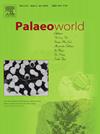IF 1.7
3区 地球科学
Q2 PALEONTOLOGY
引用次数: 0
摘要
除了一些中新世的螺旋角羚羊外,Antilopina的化石经常被称为Gazella,并被归类为属名;然而,由于在大量化石样本中观察到明显的形态差异,它们的真正分类归属难以确定。在中国广泛分布的羚羊属(Antilopina)中现存的两个属是Gazella subgutturrosa和Procapra spp,将来自中国的大量被鉴定为“Gazella”的化石标本分配给这两个现存的类群尤其具有挑战性。分子系统发育研究表明,Gazella和Procapra属于Antilopina中两个不同的分支。因此,对“Gazella”化石的研究对于了解Antilopina的分化和进化历史至关重要,Antilopina包括生活在欧亚大陆和非洲的多种属。新颅骨表现出几个独特的特征:脑壳相当长,枕髁尾侧突出,超出枕旁突;颅面轴呈弱弯曲,角核向尾端强烈倾斜。其形态不同于Antilopina的大多数其他成员。由于这些特殊的特征,我们证明了“Gazella”nihensis可能与现存的原甲龙有关的观点。有趣的是,在“Gazella”nihensis中,较长的脑壳与面部轴的弯曲程度较低,与现存的walleri Litocranius相似;现存的clarkei Ammodorcas和Antidorcas marsupialis的角核强烈地向尾端倾斜。这些相似性可能是平行进化的结果,但需要进一步的研究来探索这种有趣的相似性。本文章由计算机程序翻译,如有差异,请以英文原文为准。
A cranium of “Gazella” nihensis from Pliocene of Qinghai-Tibetan Plateau and the differentiation of early Antilopina
Fossils of Antilopina were often referred to and classified under the genus name “Gazella”, except for some Miocene spiral horned antelopes; however, their true taxonomic attribution is difficult to determine due to the significant morphological variation observed in large fossil samples. Species of two extant genera within Antilopina that are widely distributed in China are Gazella subgutturosa and Procapra spp. Assigning abundant fossil specimens identified as “Gazella” from China to these two extant groups is particularly challenging. Molecular phylogenetic studies have revealed that Gazella and Procapra belong to two distinct clades within Antilopina. Therefore, the study of fossil “Gazella” is crucial for understanding the differentiation and evolutionary history of Antilopina, which includes a diverse array of genera that lived in Eurasia and Africa. In this article, we describe a newly discovered cranium of “Gazella” nihensis from the Pliocene Epoch on the Qinghai-Tibetan Plateau. The new cranium exhibits several distinctive features: the braincase is considerably elongated, with the occipital condyles protruding caudally beyond the paroccipital process; the cranial-facial axis is weakly curved, and the horn cores are strongly inclined caudally. The morphology is distinct from most other members of Antilopina. We testified the view that “Gazella” nihensis is possibly related with the living Procapra because of these specialized features. Interestingly, in “Gazella” nihensis, the elongated braincase that is less bent from the facial axis resembles that of the living Litocranius walleri; and the strongly caudally inclined horn core that of the living Ammodorcas clarkei and Antidorcas marsupialis. These similarities may be the result of parallel evolution, but further research is needed to explore this interesting resemblance.
求助全文
通过发布文献求助,成功后即可免费获取论文全文。
去求助
来源期刊

Palaeoworld
PALEONTOLOGY-
CiteScore
4.00
自引率
5.90%
发文量
95
期刊介绍:
Palaeoworld is a peer-reviewed quarterly journal dedicated to the study of past life and its environment. We encourage submission of original manuscripts on all aspects of palaeontology and stratigraphy, comparisons of regional and global data in time and space, and results generated by interdisciplinary investigations in related fields. Some issues will be devoted entirely to a special theme whereas others will be composed of contributed articles. Palaeoworld is dedicated to serving a broad spectrum of geoscientists and palaeobiologists as well as serving as a resource for students in fields as diverse as palaeobiology, evolutionary biology, taxonomy and phylogeny, geobiology, historical geology, and palaeoenvironment.
Palaeoworld publishes original articles in the following areas:
•Phylogeny and taxonomic studies of all fossil groups
•Biostratigraphy, chemostratigraphy, chronostratigraphy
•Palaeoecology, palaeoenvironment and global changes throughout Earth history
•Tempo and mode of biological evolution
•Biological events in Earth history (e.g., extinctions, radiations)
•Ecosystem evolution
•Geobiology and molecular palaeobiology
•Palaeontological and stratigraphic methods
•Interdisciplinary studies focusing on fossils and strata
 求助内容:
求助内容: 应助结果提醒方式:
应助结果提醒方式:


